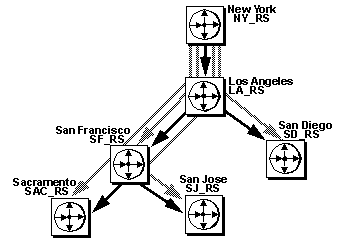Figure 6-6 revises the routes illustrated in Figure 6-2. LA_RS becomes an intermediate site between NY_RS and SF_RS, while direct and indirect routes to SB_RS are dropped.
Figure 6-6: Indirect routes altered

Here’s how you would revise the routing scheme shown in Figure 6-2 to resembles the scheme in Figure 6-6.
At each Replication Server that manages a database with a RepAgent, enter:
suspend log transfer from all
and follow the instructions in “Quiescing a replication system”. This procedure quiesces the replication system so that messages will be redirected to your new routing configuration without error.
LA_RS needs a direct route to SF_RS; create one by entering the following command at Replication Server LA_RS:
create route to SF_RS set username SF_rsi_user set password SF_rsi_ps
LA_RS requires indirect routes to SAC_RS and SJ_RS, through SF_RS.
Creating these routes instructs LA_RS to send messages to SF_RS that are destined for SAC_RS and SJ_RS. SF_RS already has direct routes to SAC_RS and SJ_RS. Enter the commands in Replication Server LA_RS:
create route to SAC_RS set next site SF_RS
create route to SJ_RS set next site SF_RS
The primary Replication Server, NY_RS, was previously configured with indirect routes through SF_RS to SAC_RS and SJ_RS. Alter those routes so that Replication Server LA_RS is the next Replication Server. Enter these commands in Replication Server NY_RS:
alter route to SAC_RS set next site LA_RS
alter route to SJ_RS set next site LA_RS
The direct route from the primary Replication Server, NY_RS, to SF_RS needs to be changed to an indirect route, with LA_RS as the intermediate Replication Server. Enter these commands in Replication Server NY_RS:
alter route to SF_RS set next site LA_RS
At each Replication Server where you previously suspended log transfer, resume log transfer connections to each Replication Server by entering:
resume log transfer from all
Refer to Chapter 4, “Managing a Replication System” for more information on resuming log transfer.
Remove the indirect route from NY_RS to SB_RS. Enter this command in NY_RS:
drop route to SB_RS
Remove the direct route from LA_RS to SB_RS. Enter this command in LA_RS:
drop route to SB_RS
The indirect route from NY_RS to SD_RS, through LA_RS, is intact.